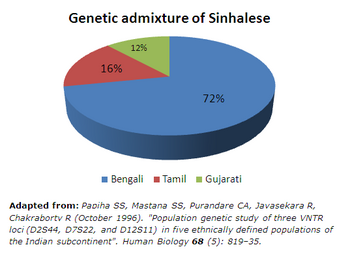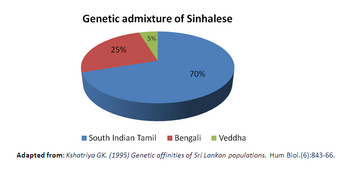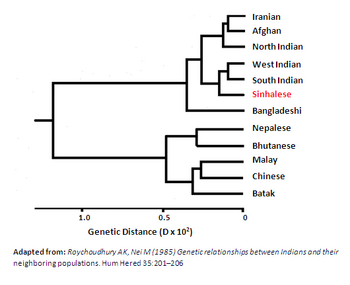Biology:Genetic studies on Sinhalese
Genetic studies on the Sinhalese is part of population genetics investigating the origins of the Sinhalese population.
All studies agree that there is a significant relationship between the Sinhalese and the Bengalis and South Indian Tamils, and that there is a significant genetic relationship between Sri Lankan Tamils and Sinhalese. This is also supported by a genetic distance study, which showed low differences in genetic distance between the Sinhalese and the Bengali, Tamil, and Keralite volunteers.[1]
Relationship to Bengalis
An Alu polymorphism analysis by Mastana S (2007) using Sinhalese, Tamil, Bengali, Gujarati (Patel), and Punjabi as parental populations found the following proportions of genetic contribution:[2]
| Statistical Method | Bengali | Tamil | North Western |
|---|---|---|---|
| Point Estimate | 57.49% | 42.5% | - |
| Maximum Likelihood Method | 88.07% | - | - |
| Using Tamil, Bengali and North West as parental population | 50-66% | 11-30% | 20-23% |
| Parental population | Bengali | Tamil | Gujarati | Punjabi |
|---|---|---|---|---|
| Using Tamil and Bengali as parental population | 70.03% | 29.97% | - | |
| Using Tamil, Bengali and Gujarati as parental population | 71.82% | 16.38% | 11.82% | |
| Using Bengali, Gujarati and Punjabi as parental population | 82.09% | - | 15.39% | 2.52% |
Analysis of X chromosome STRs by Perera et al. (2021) found the Sinhalese (as well as Sri Lankan Tamils and Sri Lankan Muslims) to be more closely related to Bengalis, than to the Indian Tamils of Sri Lanka.[3]
Genetic distance analysis by Kirk (1976) found the Sinhalese to be closer to the Bengal than they are to populations in Gujarat or the Panjab.[4]
D1S80 allele frequency (a popular allele for genetic fingerprinting) is also similar between the Sinhalese and Bengalis, suggesting the two groups are closely related.[5]
The Sinhalese also have similar frequencies of the allele MTHFR 677T (13%) to West Bengalis (17%).[6][7]
The most common y-DNA Haplogroups among the Sinhalese include Haplogroup R2 (38.5%) and Haplogroup R1a (12.8%). Haplogroup R2 also has a significant presence among West Bengalis (22.6%) and Telugus (20%),[8] whereas Haplogroup R1a peaks in the higher caste groups of North India.[9] The total Haplogroup R2 and Haplogroup R1a presence among Sinhalese is over 50%.[9]
Relationship to Indian Tamils
A genetic admixture study by Kshatriya (1995) found the Sinhalese to have a higher contribution from Indian Tamils (69.86% +/- 0.61), compared with the Bengalis (25.41% +/- 0.51).[10]
Genetic distance analysis by Roychoudhury AK et al. (1985) suggested the Sinhalese are more closely related to South and West Indian populations, than the Bengalis.[11]
Genetic distance analysis by Kirk (1976) suggested the Sinhalese are closer to the Tamils and Keralites of South India, than they are to the populations in Gujarat or the Panjab.[4]
A 2023 study by Singh et al using higher resolution markers than previous studies found that there was higher gene flow from South India to the Sinhalese than from North India, with the Sinhalese sharing the highest Identity by descent with Tamils compared to the other Indian populations studied. The study also found heightened sharing with the Maratha of north western India which was lacking in Tamil and other South Indian populations, consistent with a trace of North Indian affiliation to the Sinhalese population. The total Sinhalese sample size used was 9 individuals.[12]
Relationship to North West Indians
An Alu polymorphism analysis by Mastana S (2007) found a minor North West Indian contribution (20-23%).[13]
Analysis of X chromosome STRs by Perera et al., (2011) showed that the Sinhalese, Sri Lankan Tamil, Moor and Indian Tamils of Sri Lanka, share affinities with the Bhil (an Indigenous group) of North West India.[14]
Relationship to other major ethnic groups in Sri Lanka
A study looking at genetic variation of the FUT2 gene in the Sinhalese and Sri Lankan Tamil population, found similar genetic backgrounds for both ethnic groups, with little genetic flow from other neighbouring Asian population groups.[15] Studies have also found no significant difference with regards to blood group, blood genetic markers (Saha, 1988) and single-nucleotide polymorphism between the Sinhalese and other ethnic groups in Sri Lanka.[16][17][18] Another study has also found "no significant genetic variation among the major ethnic groups in Sri Lanka".[19] This is further supported by a study which found very similar frequencies of alleles MTHFR 677T, F2 20210A & F5 1691A in Indian Tamil, Sinhalese, Sri Lankan Tamil, and Sri Lankan Moor populations.[7]
Relationship to East and Southeast Asians
Genetic studies show that the Sinhalese have received some genetic flow from neighboring populations in East Asia and Southeast Asia, such as from the ethnically diverse and disparate Tibeto-Burman peoples and Austro-Asiatic peoples,[20] which is due to their close genetic links to Northeast India.[21][22][23] A 1985 study conducted by Roychoudhury AK and Nei M, indicated the values of genetic distance showed that the Sinhalese people were slightly closer to Mongoloid populations due to gene exchange in the past.[11][24] In regards to comparisons of root and canal morphology of Sri Lankan mandibular molars, it showed that they were further away from Mongoloid populations.[25] Among haplogroups found in East Asian populations, a lower frequency of East Asian mtDNA haplogroup, G has been found among the populations of Sri Lanka alongside haplogroup D in conjunction with the main mtDNA haplogroup of Sri Lanka's ethnic groups, haplogroup M.[26] In regards to Y-DNA, Haplogroup C-M130 is found at low to moderate frequencies in Sri Lanka.[27]
Genetic markers of immunoglobulin among the Sinhalese show high frequencies of afb1b3 which has its origins in the Yunnan and Guangxi provinces of southern China.[28] It is also found at high frequencies among Odias, certain Nepali and Northeast Indian, southern Han Chinese, Southeast Asian and certain Austronesian populations of the Pacific Islands.[28] At a lower frequency, ab3st is also found among the Sinhalese and is generally found at higher frequencies among northern Han Chinese, Tibetan, Mongolian, Korean and Japanese populations.[28] The Transferrin TF*Dchi allele which is common among East Asian and Native American populations is also found among the Sinhalese.[11] HumDN1*4 and HumDN1*5 are the predominant DNase I genes among the Sinhalese and are also the predominant genes among southern Chinese ethnic groups and the Tamang people of Nepal.[29] A 1988 study conducted by N. Saha, showed the high GC*1F and low GC*1S frequencies among the Sinhalese are comparable to those of the Chinese, Japanese, Koreans, Thais, Malays, Vietnamese, Laotians and Tibetans.[30] A 1998 study conducted by D.E. Hawkey showed dental morphology of the Sinhalese is closely related to those of the Austro-Asiatic populations of East and Northeast India.[20] Hemoglobin E a variant of normal hemoglobin, which originated in and is prevalent among populations in Southeast Asia, is also common among the Sinhalese and can reach up to 40% in Sri Lanka.[31]
Paternal Line
Y-DNA of Sinhalese
The most common Y-chromosome DNA haplogroups found in the Sinhalese are Haplogroup R2, Haplogroup R1a and Haplogroup L. Haplogroup R2 has a significant presence among West Bengalis (22.6%) and Telugus (20%),[8] whereas Haplogroup R1a peaks in the higher caste groups of North India.[9] Haplogroup L peaks at 68% among the Koraga people of coastal Karnataka and north Kerala.[32] It is also the single largest male lineage (36.8%) among the Jat people of Northern India and is found at 16.33% among the Gujar's of Jammu and Kashmir.
| Population | n | C | E | F | G | H | I | J | K | L | N | O | P | Q | R | R1 | R1a | R1b | R2 | T | Others | Reference |
|---|---|---|---|---|---|---|---|---|---|---|---|---|---|---|---|---|---|---|---|---|---|---|
| Sinhalese | 39 | Template:Gold (color) | 0 | 10.3% | Template:Turquoise | 10.3% | Template:Olive | 10.3% | Template:Teal | 18% | Template:Lime | Template:Silver (color) | Template:Aqua | Template:Cyan | 0 | 0 | Template:Pink | 0 | 38.5% | Template:Yellow | Kivisild2003[9] |
Maternal Line
MtDNA of Sinhalese
Ranweera et al. (2014) found the most common mtDNA haplogroup in the Sinhalese to be Haplogroup M, Haplogroup U (U7a) and Haplogroup R(R30b) and Haplogroup G (G3a1′2).[33][34]
Haplogroup M represents the dispersal of modern humans around 60.000 years ago along the southern Asian coastline following a southern coastal route across Arabia and India to reach Australia short after.[35]
Haplogroup U7 is considered a West Eurasian–specific mtDNA haplogroup, believed to have originated in the Black Sea area approximately 30,000 years ago. In South Asia, U7 occurs in about 12% in Gujarat, while for the whole of India its frequency stays around 2%, and 5% in Pakistan . In the Vedda people of Sri Lanka it reaches its highest frequency of 13.33% (subclade U7a). It is speculated that large-scale immigration carried these mitochondrial haplogroups into India.[36]
Chaubey states that "considerable number of maternal lineages of Sri Lanka is shared with India, more precisely with southern part of India."[37]
References
- ↑ Kirk, R. L. (July 1976). "The legend of Prince Vijaya — a study of Sinhalese origins". American Journal of Physical Anthropology 45 (1): 91–99. doi:10.1002/ajpa.1330450112.
- ↑ "Molecular anthropology: population and forensic genetic applications". Anthropologist Special 3: 373–383. 2007. http://www.krepublishers.com/06-Special%20Volume-Journal/T-Anth-00-Special%20Volumes/T-Anth-SI-03-Anth-Today-Web/Anth-SI-03-29-Mastana-S/Anth-SI-03-29-Mastana-S-Tt.pdf.
- ↑ Perera, N., Galhena, G. and Ranawaka, G., 2021. X-chromosomal STR based genetic polymorphisms and demographic history of Sri Lankan ethnicities and their relationship with global populations. Scientific reports, 11(1), pp.1-12.
- ↑ 4.0 4.1 "The legend of Prince Vijaya – a study of Sinhalese origins". American Journal of Physical Anthropology 45 (1): 91–99. July 1976. doi:10.1002/ajpa.1330450112.
- ↑ Surinder Singh Papiha (1999). Genomic Diversity: Applications in Human Population Genetics. London: Springer. 7.
- ↑ "MTHFR gene polymorphisms analyzed in population from Kolkata, West Bengal". Indian Journal of Human Genetics 13 (1): 38. January 2007. doi:10.4103/0971-6866.32035. PMID 21957342.
- ↑ 7.0 7.1 "Prevalence of genetic thrombophilic polymorphisms in the Sri Lankan population--implications for association study design and clinical genetic testing services". Experimental and Molecular Pathology 87 (2): 159–62. October 2009. doi:10.1016/j.yexmp.2009.07.002. PMID 19591822.
- ↑ 8.0 8.1 "Punctuated bursts in human male demography inferred from 1,244 worldwide Y-chromosome sequences". Nature Genetics 48 (6): 593–9. June 2016. doi:10.1038/ng.3559. PMID 27111036.
- ↑ 9.0 9.1 9.2 9.3 "The genetic heritage of the earliest settlers persists both in Indian tribal and caste populations". American Journal of Human Genetics 72 (2): 313–332. February 2003. doi:10.1086/346068. PMID 12536373.
- ↑ "Genetic affinities of Sri Lankan populations". Human Biology (American Association of Anthropological Genetics) 67 (6): 843–66. December 1995. PMID 8543296.
- ↑ 11.0 11.1 11.2 "Genetic relationships between Indians and their neighboring populations". Human Heredity 35 (4): 201–6. 1985. doi:10.1159/000153545. PMID 4029959.
- ↑ Prajjval Pratap Singh, Sachin Kumar, Nagarjuna Pasupuleti, Niraj Rai, Gyaneshwer Chaubey, R. Ranasinghe, "Reconstructing the population history of Sinhalese, the major ethnic group in Śrī Laṅkā," iScience, August 31, 2023, DOI: https://doi.org/10.1016/j.isci.2023.107797.
- ↑ "Molecular anthropology: population and forensic genetic applications". Anthropologist Special 3: 373–383. 2007. http://www.krepublishers.com/06-Special%20Volume-Journal/T-Anth-00-Special%20Volumes/T-Anth-SI-03-Anth-Today-Web/Anth-SI-03-29-Mastana-S/Anth-SI-03-29-Mastana-S-Tt.pdf.
- ↑ Perera, N., Galhena, G. and Ranawaka, G., 2021. X-chromosomal STR based genetic polymorphisms and demographic history of Sri Lankan ethnicities and their relationship with global populations. Scientific reports, 11(1), pp.1-12.
- ↑ "Denaturing high-performance liquid chromatography-based genotyping and genetic variation of FUT2 in Sri Lanka". Transfusion 45 (12): 1934–9. December 2005. doi:10.1111/j.1537-2995.2005.00651.x. PMID 16371047.
- ↑ "Blood genetic markers in Sri Lankan populations--reappraisal of the legend of Prince Vijaya". American Journal of Physical Anthropology 76 (2): 217–25. 1988. doi:10.1002/ajpa.1330760210. PMID 3166342.
- ↑ "Blood Groups of the Sinhalese". Man 7 (1): 122–127. 1972. doi:10.2307/2799860.
- ↑ "A study of three candidate genes for pre-eclampsia in a Sinhalese population from Sri Lanka". The Journal of Obstetrics and Gynaecology Research 35 (2): 234–42. April 2009. doi:10.1111/j.1447-0756.2008.00926.x. PMID 19708171.
- ↑ "Genetic profile of 11 autosomal STR loci among the four major ethnic groups in Sri Lanka". Forensic Science International. Genetics 3 (3): e105-6. June 2009. doi:10.1016/j.fsigen.2008.10.002. PMID 19414153.
- ↑ 20.0 20.1 The Evolution and History of Human Populations in South Asia: Inter-disciplinary Studies in Archaeology, Biological Anthropology, Linguistics and Genetics. Springer Science & Business Media. 2007. ISBN 978-1-4020-5562-1. https://books.google.com/books?id=Qm9GfjNlnRwC.[page needed]
- ↑ "Population differences of two coding SNPs in pigmentation-related genes SLC24A5 and SLC45A2". International Journal of Legal Medicine 121 (1): 36–9. January 2007. doi:10.1007/s00414-006-0112-z. PMID 16847698.
- ↑ "The genetic heritage of the earliest settlers persists both in Indian tribal and caste populations". American Journal of Human Genetics 72 (2): 313–32. February 2003. doi:10.1086/346068. PMID 12536373.
- ↑ "Polarity and temporality of high-resolution y-chromosome distributions in India identify both indigenous and exogenous expansions and reveal minor genetic influence of Central Asian pastoralists". American Journal of Human Genetics 78 (2): 202–21. February 2006. doi:10.1086/499411. PMID 16400607.
- ↑ "Morphology to Molecular Anthropology: Castes and Tribes of India". International Journal of Human Genetics 9 (3–4): 145–230. 4 September 2017. doi:10.1080/09723757.2009.11886070.
- ↑ "Root and canal morphology of permanent mandibular molars in a Sri Lankan population". Odontology 95 (1): 16–23. July 2007. doi:10.1007/s10266-007-0074-8. PMID 17660977.
- ↑ "Mitochondrial DNA history of Sri Lankan ethnic people: their relations within the island and with the Indian subcontinental populations". Journal of Human Genetics 59 (1): 28–36. January 2014. doi:10.1038/jhg.2013.112. PMID 24196378.
- ↑ "Y-DNA Haplogroup C and its Subclades - 2017". International Society of Genetic Genealogy. http://isogg.org/tree/ISOGG_HapgrpC.html.
- ↑ 28.0 28.1 28.2 "The origin of the Japanese race based on genetic markers of immunoglobulin G". Proceedings of the Japan Academy. Series B, Physical and Biological Sciences 85 (2): 69–82. 2009. doi:10.2183/pjab.85.69. PMID 19212099. Bibcode: 2009PJAB...85...69M.
- ↑ "Global analysis of genetic variations in a 56-bp variable number of tandem repeat polymorphisms within the human deoxyribonuclease I gene". Legal Medicine 17 (4): 283–6. July 2015. doi:10.1016/j.legalmed.2015.01.005. PMID 25771153.
- ↑ Anthropology of Development: Commemoration Volume in the Honour of Professor I.P. Singh. Mittal Publications. 1992. ISBN 978-81-7099-328-5. https://books.google.com/books?id=U6WhkmvI324C.[page needed]
- ↑ Genetic Disorders of the Indian Subcontinent. Springer Science & Business Media. 2012. ISBN 978-1-4020-2231-9. https://books.google.com/books?id=2grSBwAAQBAJ.[page needed]
- ↑ Sengupta, Sanghamitra; Zhivotovsky, Lev A.; King, Roy; Mehdi, S. Q.; Edmonds, Christopher A.; Chow, Cheryl-Emiliane T.; Lin, Alice A.; Mitra, Mitashree et al. (2006). "Polarity and Temporality of High-Resolution Y-Chromosome Distributions in India Identify Both Indigenous and Exogenous Expansions and Reveal Minor Genetic Influence of Central Asian Pastoralists". American Journal of Human Genetics 78 (2): 202–221. doi:10.1086/499411. ISSN 0002-9297. PMID 16400607.
- ↑ Ranaweera, Lanka; Kaewsutthi, Supannee; Win Tun, Aung; Boonyarit, Hathaichanoke; Poolsuwan, Samerchai; Lertrit, Patcharee (January 2014). "Mitochondrial DNA history of Sri Lankan ethnic people: their relations within the island and with the Indian subcontinental populations". Journal of Human Genetics 59 (1): 28–36. doi:10.1038/jhg.2013.112. PMID 24196378.
- ↑ Ranasinghe, Ruwandi; Tennekoon, Kamani H.; Karunanayake, Eric H.; Lembring, Maria; Allen, Marie (November 2015). "A study of genetic polymorphisms in mitochondrial DNA hypervariable regions I and II of the five major ethnic groups and Vedda population in Sri Lanka". Legal Medicine 17 (6): 539–546. doi:10.1016/j.legalmed.2015.05.007. PMID 26065620.
- ↑ Marrero, P.; Abu-Amero, K. K.; Larruga, J. M.; Cabrera, V. M. (2016). "Carriers of human mitochondrial DNA macrohaplogroup M colonized India from southeastern Asia". BMC Evolutionary Biology 16 (1): 246. doi:10.1186/s12862-016-0816-8. PMID 27832758.
- ↑ "Most of the extant mtDNA boundaries in south and southwest Asia were likely shaped during the initial settlement of Eurasia by anatomically modern humans". BMC Genetics 5: 26. August 2004. doi:10.1186/1471-2156-5-26. PMID 15339343.
- ↑ Chaubey, G. Language isolates and their genetic identity: a commentary on mitochondrial DNA history of Sri Lankan ethnic people: their relations within the island and with the Indian subcontinental populations. J Hum Genet 59, 61–63 (2014). https://doi.org/10.1038/jhg.2013.122
 |





